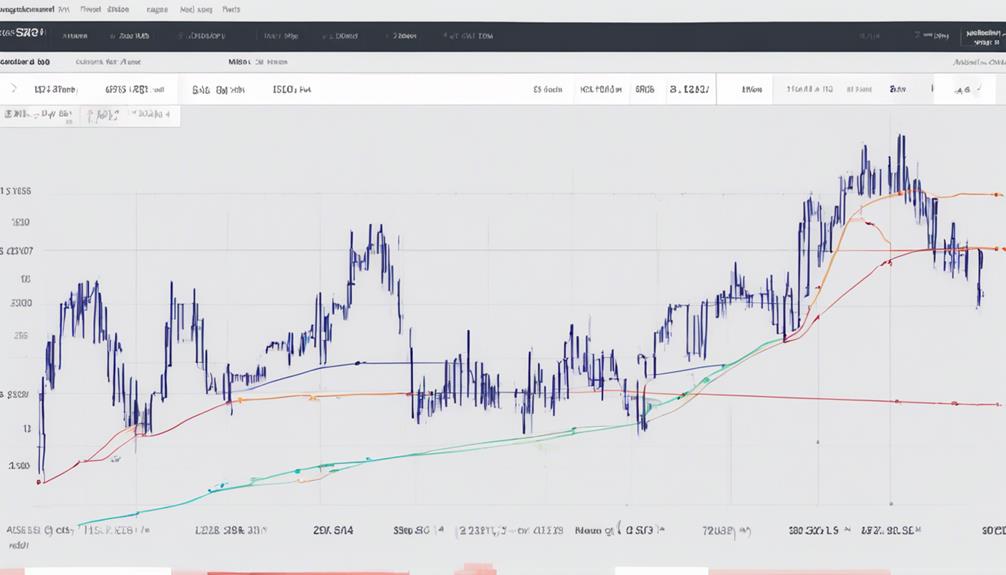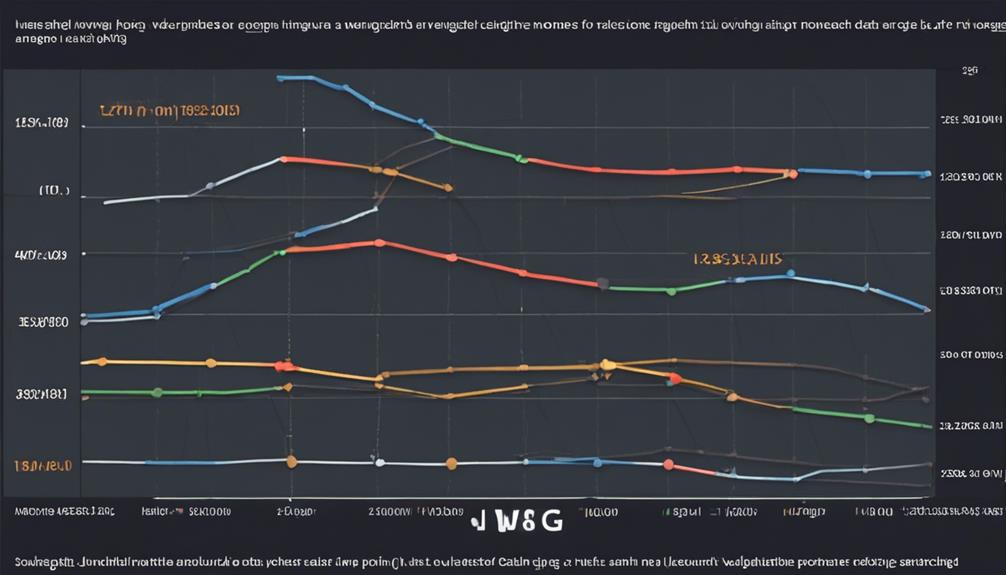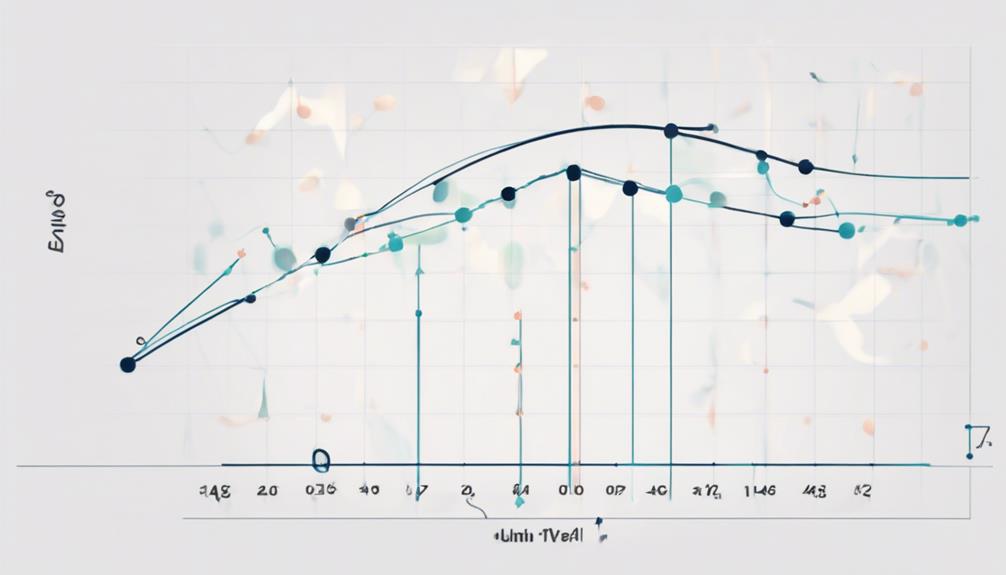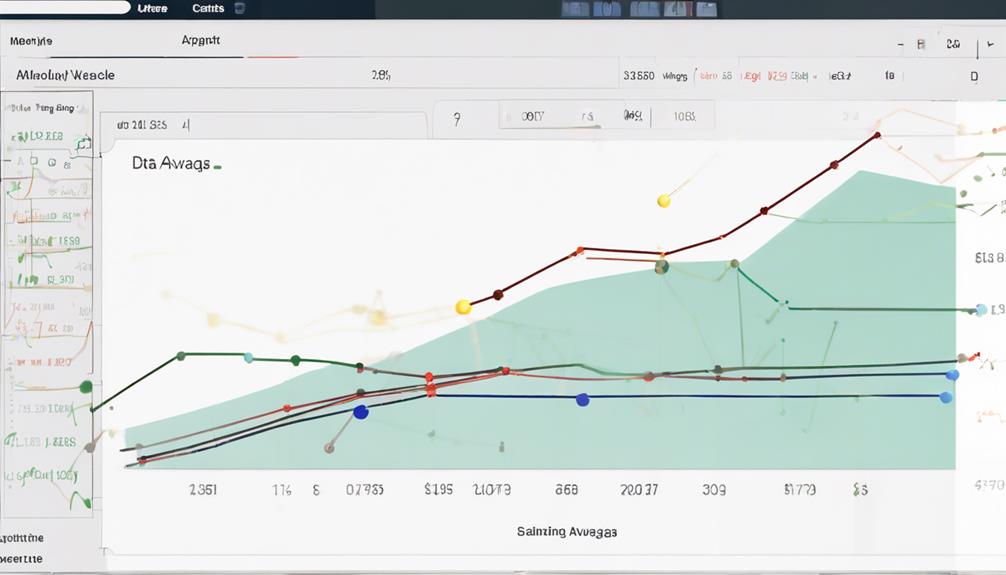When it comes to calculating moving averages, you have a range of methods at your disposal, each with its unique approach and benefits.
From the straightforward arithmetic method to the more nuanced exponential and weighted approaches, understanding these techniques is crucial for effective trend analysis in financial markets.
Stay tuned to discover how these methods can enhance your trading strategies and provide valuable insights into market movements and potential opportunities.
Simple Moving Average (SMA)
The Simple Moving Average (SMA) calculation involves summing up closing prices over a specific period and dividing by the number of periods. Traders utilize SMA in financial analysis to identify trend direction based on historical data. By averaging a defined number of closing prices, SMA smooths out fluctuations, making it a valuable tool in technical analysis.
Unlike the Exponential Moving Average (EMA), which assigns more weight to recent data points, SMA treats all data equally within the period. This characteristic makes SMA a straightforward indicator of price trends. Traders often rely on SMA crossovers to signal potential shifts in market trends, offering insights into possible buy or sell opportunities.
Understanding how to calculate and interpret SMA can significantly enhance your analytical skills in financial markets.
Exponential Moving Average (EMA)

When calculating the Exponential Moving Average (EMA), traders assign more weight to recent price data points, enabling a heightened responsiveness to current market trends.
- EMA calculation incorporates a smoothing factor that adjusts the weightage of recent prices, making it more sensitive to market changes.
- The recursive nature of EMA formula, which includes yesterday's EMA value, allows for quick adaptation to new information.
- Traders often favor EMA over Simple Moving Average (SMA) due to its responsiveness, particularly in volatile markets.
EMA is a valuable tool in technical analysis, aiding in the identification of short-term trends and potential reversal points in asset prices. Its ability to swiftly react to market movements makes it a popular choice among traders seeking to stay ahead of evolving market conditions.
Weighted Moving Average

Weighted Moving Average method applies varying weights to data points based on their relative significance in the calculation, emphasizing recent data for more responsive trend analysis.
This method involves assigning weight factors to each data point before averaging them, giving more weight to recent data compared to older ones.
Weighted Moving Average is particularly useful in financial analysis where up-to-date information is crucial for decision-making. By focusing on recent data points, the Weighted Moving Average provides a dynamic indicator of trends, making it a preferred choice for analysts seeking a responsive trend analysis tool.
Its application in financial analysis enhances the ability to adapt quickly to changing market conditions and make informed decisions based on the most relevant data.
Triangular Moving Average

Applying a triangular weighting function, the Triangular Moving Average (TMA) refines data analysis by assigning more weight to central data points, distinguishing it from the Simple Moving Average (SMA). TMA smooths data over a specific period, giving emphasis to the central values for more accurate trend analysis. It calculates the average by applying the SMA formula twice, reducing lag in trend identification.
- TMA assigns more weight to central data points, smoothing out fluctuations.
- TMA responds more quickly to recent price changes compared to SMA.
- TMA's triangular weighting pattern enhances trend visibility by focusing on the middle values.
What are the Best Methods for Calculating Moving Averages and How Can They be Decoded Effectively?
When calculating moving averages, use simple or exponential methods for accurate results. Choose the right time period for your analysis and be consistent. Analyze the trend direction using the moving averages. To decode effectively, pay attention to crossovers and use additional indicators for confirmation. Following these ten tips for moving averages will help you make informed decisions.
Adaptive Moving Average

Utilizing a dynamic approach, the Adaptive Moving Average (AMA) adjusts its sensitivity to market conditions, enhancing trend detection accuracy. Developed by Tushar Chande in 1991, AMA aims to reduce lag and improve trend identification by dynamically altering the number of periods in its calculation based on market volatility.
This adjustment emphasizes recent price data during turbulent market conditions, allowing AMA to adapt more effectively to rapid changes. Unlike traditional moving averages, AMA's calculation formula changes in response to market fluctuations, making it a valuable tool for traders in fast-moving markets.
How Can I Use Moving Averages Effectively in Calculations?
When using moving averages decoding tips, it is important to understand how they can be effectively applied in calculations. By tracking the average price of a security over a specific period, moving averages can help to identify trends and potential entry or exit points for traders and investors.
Frequently Asked Questions
What Is the Most Accurate Moving Average Strategy?
For the most accurate moving average strategy, consider your objectives, time frame, and market conditions. Utilize exponential moving averages for responsiveness, longer-term averages for trend analysis, and combinations with different periods for enhanced accuracy in trend identification.
What Is the Method of Finding Moving Averages?
To find moving averages, sum closing prices over a set period and divide by the number of periods. This process helps smooth data, revealing trends and support/resistance levels in asset prices. Common types are Simple Moving Average (SMA) and Exponential Moving Average (EMA).
Which Is Better EMA or Wma?
When deciding between EMA and WMA, consider your preference for adaptability and responsiveness. EMA quickly adjusts to price changes with a smoothing factor, while WMA provides customized analysis with weighted periods. Choose wisely based on your trading style.
What Is the 5 10 20 EMA Strategy?
To implement the 5 10 20 EMA strategy, calculate the exponential moving averages with periods of 5, 10, and 20. By analyzing trends and identifying entry/exit points, this strategy offers insights into short-term market dynamics.
Conclusion
You have now learned about the five best methods to calculate moving averages:
- Simple Moving Average (SMA)
- Exponential Moving Average (EMA)
- Weighted Moving Average
- Triangular Moving Average
- Adaptive Moving Average
Each method offers unique benefits and can be tailored to suit different trading strategies.
By mastering these techniques, you can gain a deeper understanding of market trends and make more informed decisions.
So, why settle for outdated analysis methods when you can utilize these sophisticated moving average calculations?


